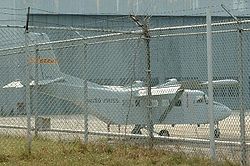- Dominion Skytrader
-
Skytrader UV-23A Role STOL utility aircraft Manufacturer Dominion Aircraft First flight 21 April 1975 Number built 1 The Dominion Skytrader was a prototype STOL utility aircraft built in the United States in the early 1970s. Attempts to market the aircraft continued until the late 1980s, but proved fruitless. The Skytrader was a conventional high-wing, strut-braced monoplane with fixed tricycle undercarriage. The design was optimised for easy freight handling and featured a fuselage of rectangular cross-section with large loading doors to the side and a loading ramp at the rear. The aircraft's tail unit was angled upwards from the rear fuselage to facilitate loading operations beneath it, and the main undercarriage was fitted in sponsons on the fuselage sides so as not to intrude into the internal cargo volume. Passenger, freight, executive transport, and water-bomber versions were projected.
Development
Work on the aircraft commenced in 1972, and the prototype flew on 21 April 1975. Marketing the aircraft proved difficult, however, and despite a flurry of initial interest, by 1977, only two firm orders are known to have been placed. Two years later, the bank that had been financing the project collapsed and Dominion went bankrupt. The prototype and the program were purchased the following year by Grant MacCoon, and over the next few years were bought and sold by a number of entities, finally becoming the property of a new firm, Skytrader Corporation, in 1984.
Skytrader proposed a revised version of the original design as the Skytrader ST1700 or Conestoga. This had a stretched cabin, T-tail, redesigned nose, wings, and landing gear, and was to be turboprop powered. A scaled-down version was to be offered as the ST1400 Commuterliner. Apart from passenger and freight versions, dedicated military versions were also proposed as the Evader, carrying 26 troops, or the smaller Scout. This would have been able to carry 12-15 troops and provision was made for armament in the form of 2.75 in air-to-ground rockets. In 1987, Skytrader announced a deal with Mitsui that would provide $20.5 million to fund FAA certification of the ST1700, and initial production of the Scout.
The Mitsui money never appeared, and the following year, Skytrader made co-production deals with the government of the Philippines and Samsung, but these did not eventuate either. The final chapter in the Skytrader's development was the entry of the Scout in a US Army competition for an intelligence gathering plane. During the late 1980s, the U.S. Southern Command became interested in acquiring a reconnaissance plane which would do well in the rugged terrain and with the clandestine operations that the command was executing at the time. A contest, named Grizzly Hunter, was opened for interested contractors to enter candidate airplanes for consideration.
The Scout was entered as a joint project between Skytrader and McDonnell Douglas Helicopter, and was selected as the winning design, receiving the designation UV-23. Revisions to the original Scout design included blown wings and new propellers and gearboxes to significantly reduce the aircraft's IR and noise signatures. The Skytrader 800 prototype was re-engined at this point, and flew with Turbomeca Astazou XIV turboprops. Before any production of the UV-23 could be undertaken, however, Grizzly Hunter was cancelled and replaced by a different requirement which was won by the RC-7. With the Army order falling through, Skytrader declared bankruptcy and was liquidated in August 1989.
As of 2007, the prototype lay derelict, with engines stripped, at Washington County Regional Airport, in Hagerstown, Maryland.
Variants
- Skytrader 800
- Dominion Aircraft version with Lycoming IO-720 engines (1 built)
- ST-1700
- Skytrader Corp version with Pratt & Whitney Canada PT6 engines and many airframe changes (not built)
- Scout
- Militarised ST-1700, designated UV-23 for US Army
Specifications (Skytrader 800)
Data from Jane's All The World's Aircraft 1976-77 [1]
General characteristics
- Crew: Two pilots
- Capacity: 12 passengers
- Length: 41 ft 0 in (12.50 m)
- Wingspan: 55 ft 0 in (16.76 m)
- Height: 18 ft 10¾ in (5.76 m)
- Wing area: 385 ft2 (35.77 m2)
- Empty weight: 4,950 lb (2,245 kg)
- Gross weight: 8,500 lb (3,855 kg)
- Powerplant: 2 × Lycoming IO-720-B1A eight-cylinder air-cooled horizontally opposed piston engine, 400 hp (298 kW) each
Performance
- Maximum speed: 210 mph (338 km/h)
- Cruise speed: 150[2] mph (241 km/h)
- Range: 1,430 miles (2,300 km)
- Service ceiling: 17,500 ft (5,355 m)
- Rate of climb: 1,600 ft/min (8.1 m/s)
References
- Borch, Fred L.; Robert F. Dorr (15 January 2007). "Lone UV-23 was designed for intelligence missions". Army Times: p.52.
- "Hagerstown V-23A Decays". Aeroplane: p.9. February 2007.
- "Pennsylvania party". Flight International: p.10. 3 July 1975. http://www.flightglobal.com/PDFArchive/View/1975/1975%20-%201128.html. Retrieved 2008-02-24.
- "Skytrader flies turboprop UV-23". Flight International: p.13. 4 March 1989. http://www.flightglobal.com/PDFArchive/View/1989/1989%20-%200535.html?search=skytrader. Retrieved 2008-02-24.
- "Skytrader Scout Stol sale in balance". Flight International: p.14. 15 October 1988. http://www.flightglobal.com/PDFArchive/View/1988/1988%20-%202992.html. Retrieved 2008-02-24.
- "Skytrader spotlight". Flight International: p.75. 17 July 1975. http://www.flightglobal.com/PDFArchive/View/1975/1975%20-%201249.html. Retrieved 2008-02-24.
- Taylor, John W.R. (1976). Jane's All the World's Aircraft 1976-77. London: Jane's Yearbooks. ISBN 0-354-00538-3.
- Taylor, John W.R.. Jane's All the World's Aircraft 1977-78. London: Jane's Yearbooks. pp. 288–289.
- Taylor, Michael J. H. (1989). Jane's Encyclopedia of Aviation. London: Studio Editions. pp. 326. ISBN 0710607105.
External links
United States tri-service STOL and VTOL aircraft designations post-1962 Lists relating to aviation General Aircraft (manufacturers) · Aircraft engines (manufacturers) · Airlines (defunct) · Airports · Civil authorities · Museums · Registration prefixes · Rotorcraft (manufacturers) · TimelineMilitary Accidents/incidents Records Categories:- United States civil utility aircraft 1970–1979
- Dominion aircraft
- Twin-engined aircraft
- Cancelled aircraft projects
Wikimedia Foundation. 2010.

